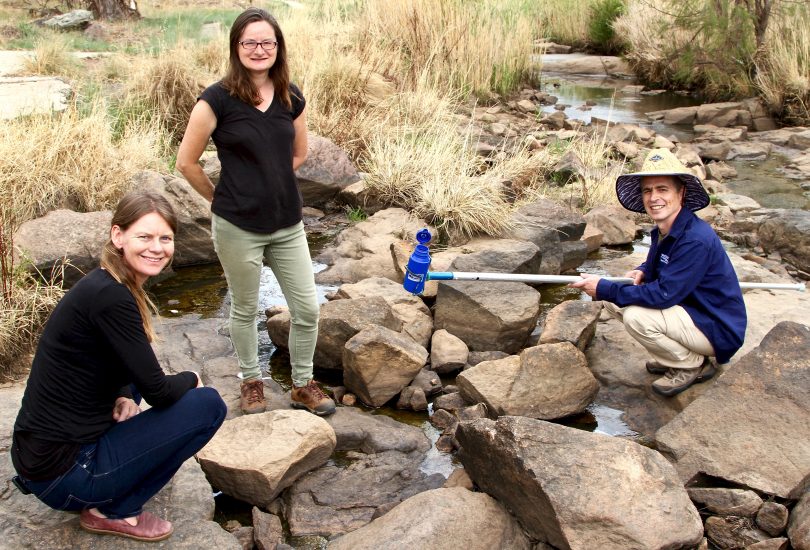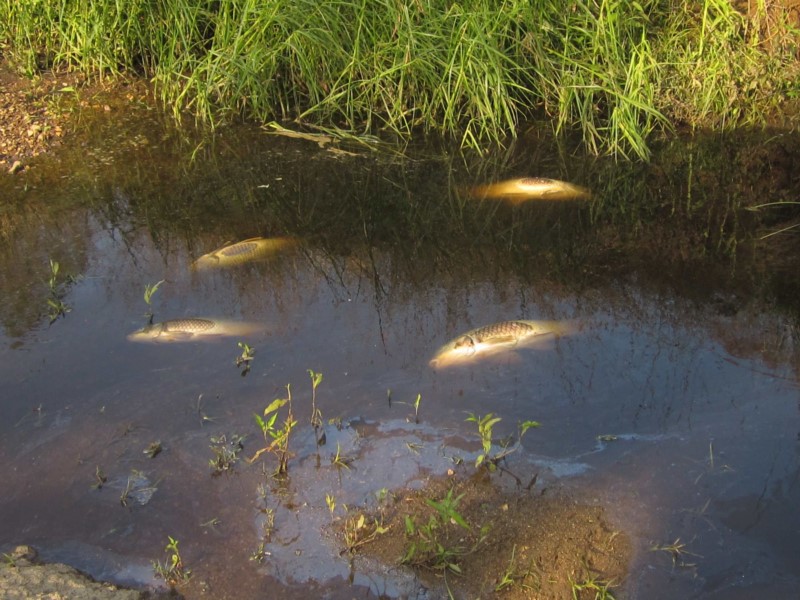
Karissa Preuss (left) of the Ginninderra Catchment Group with Umbagong Landcare Group member Dr Caroline Wenger and Waterwatch coordinator Bruno Ferronato checking the water of the catchment at Latham. Photo: Michael Weaver, Region Media.
Dead fish have littered the Ginninderra Creek stepping stones at Umbagong District Park in Latham throughout January, with tests by local Waterwatch volunteers revealing dissolved oxygen levels were almost zero.
Thick, oily films on the water surface have also been regularly observed and were prevalent when Region Media visited the catchment last week and spoke with concerned land carers.
Umbagong Landcare Group member and an expert in flooding related to climate changes, Dr Caroline Wenger, said most of the dead fish are carp, but dead redfin have also been spotted.
Dr Wenger said the cause of the fish deaths was a lack of oxygen due to a blackwater event which occurs when too much organic matter is washed into the waterway. As the organic matter decays, carbon dissolves in the water which depletes oxygen levels and makes the water appear black.
A water test by Waterwatch volunteer Lesley Harland on 18 January showed dissolved oxygen levels in the water were almost zero.
“We may not cry over carp, but being the hardiest critters in the water, their death is bad news for the health of other organisms in the creek that need oxygenated water, including many unseen smaller species of fish,” Dr Wenger said.
Carp have also been observed gasping for air on the surface of the water.

Dead carp at Umbagong District Park on 19 January. Photo: John Fitzgerald.
As part of the Upper Murrumbidgee Waterwatch Program, monthly samples of water quality are taken by Landcare group volunteers and provided to the EPA.
Waterwatch coordinator Bruno Ferronato said he is one of an army of volunteers who are the eyes and ears for issues in the waterways.
Mr Ferronato said while it is good to have rain to regularly flush the creeks and waterways, a flash-flooding event can have detrimental effects.
“We’ve seen in the Waterwatch data that every time there is a flood, there is a peak in the phosphorus levels which accumulates in the drains and river beds,” he said.
Mr Ferronato explained that phosphorus mainly comes from the run-off of common fertilisers into waterways. He said when phosphorus levels are too high, it speeds the breakdown of mineral and organic nutrients. This often results in blue-green algae forming.
Dr Wenger said they began noticing dead fish after the first hail event in Canberra in mid-January. A second, more severe hail storm occurred on 20 January.
“It looks like all of the fish kill events were noticed at the same time on 18 January,” Dr Wenger said. Tests that day revealed less than 0.1 milligrams of oxygen per litre of water.
Fish ecologists have since inspected Ginninderra Creek and ACT rangers removed the dead fish.
The ACT Government’s Catchment Programs Officer, Plaxy McCulloch, told the Landcare group they were aware of three other fish kills in the ACT in January. These occurred at Giralang Pond on 20 January, Dickson Wetland on 19 January and Tuggeranong Weir on 21 January.
Oxygen levels in the water have since increased, but remain perilously low.
“In the last year, oxygen levels have been around 3-4 milligrams per litre of water, which is still very low, but once we had the rain and hail event, oxygen levels were almost nothing,” Mr Ferronato said.
The problem is compounded when the waterway stops flowing and is made worse by significant rain or hail.
“If we had a controlled release of water from the lake [Ginninderra], that would probably do a good job of flushing the problem through,” Dr Wenger said.
“But recently, we had a lot of hail and detritus [branches, twigs and organic matter] which all go through the stormwater drains and into the creek, which temporarily makes the problem worse as the organic matter breaks down.”
The executive officer of the Ginninderra Catchment Group, Karissa Preuss, said more than 40 per cent of Canberra’s population lives near the Ginninderra catchment and this also contributes to the poor health of the waterways.
“This issue really highlights the value of having community land carers and water watchers on the ground and there needs to be a continued investment so that the community-government partnership can continue,” Ms Preuss said.
Fish kills or other waterways issues can be reported via the reporting pollution link on the Access Canberra website or by phoning 132 281.












